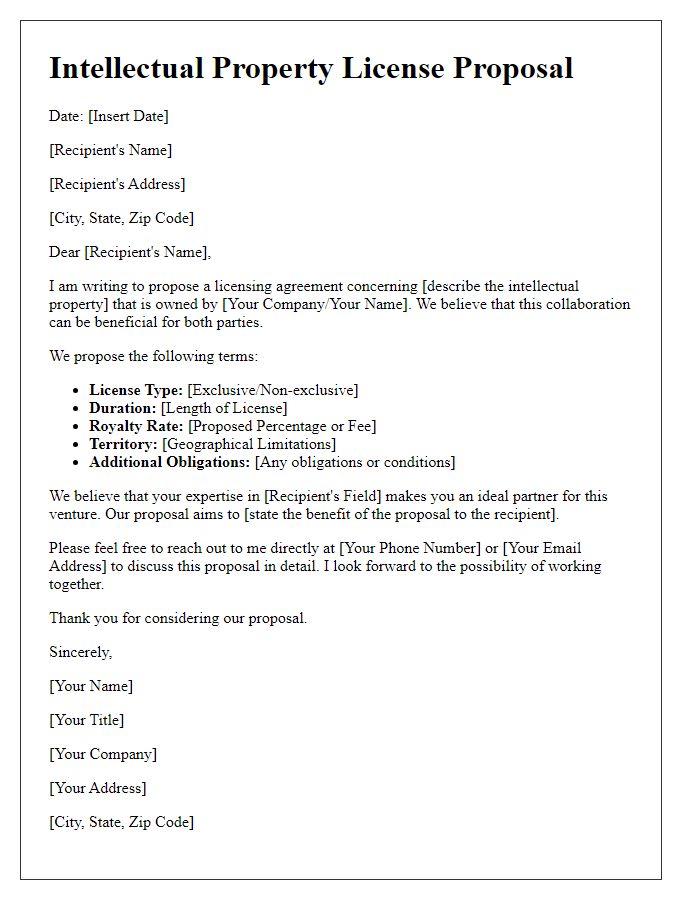Are you considering offering an intellectual property license but unsure how to craft the perfect letter? You're in the right place! Writing a clear and concise letter can make all the difference in conveying your intentions and establishing a professional relationship. Let's dive deeper into the essential components of a successful intellectual property license offerâread on!

Clearly defined scope of license
A clearly defined scope of license is essential in intellectual property agreements to avoid misunderstandings and ensure that both parties understand their rights and obligations. This includes specifying the type of intellectual property, such as patents, trademarks, copyrights, and trade secrets, along with geographic limitations relevant to the license's use, like specific countries or regions (e.g., United States, Europe, Asia-Pacific). The duration of the license should also be established, detailing whether it is exclusive, non-exclusive, or sole. Additionally, the permitted uses of the intellectual property must be outlined, including any restrictions on sublicensing or modifications. Payment terms, such as royalty rates or lump-sum fees, should be included, along with a clear definition of any reporting obligations related to usage. Overall, a well-defined scope of the license helps to create a transparent framework for both the licensor and licensee to operate within.
Duration and renewal terms
A comprehensive intellectual property license offer details the duration of the license agreement and the conditions for renewal. The initial term may span a specified number of years, such as three to five, following which both parties must consider renewal options based on the terms outlined in the contract. Renewal may require mutual consent, evaluation of performance metrics, or stipulated notifications (e.g., 90 days prior to expiration). Additionally, adjustments in licensing fees may be discussed, reflecting changes in market conditions or product enhancements during the renewal phase. Clear stipulations regarding intellectual property rights protection and obligations for both the licensor (the entity granting permission) and licensee (the entity receiving permission) are essential for a successful partnership.
Payment and royalties structure
The payment and royalties structure outlined in intellectual property license agreements is crucial for both licensors and licensees. Typically, upfront payments often serve as an initial fee for acquiring the rights to utilize the intellectual property, which may range from thousands to millions of dollars, depending on the property's value and market potential. Royalties, calculated as a percentage of sales revenue or a fixed amount per unit sold, are commonly agreed upon terms that can fluctuate based on sales volume (e.g., 5% to 15% of net sales). Additionally, milestone payments may be incorporated, providing structured compensation at specified phases, such as reaching sales targets or launching new products related to the licensed property. Detailed reporting requirements will ensure transparent tracking of sales, and audit rights may be established for the licensor to verify compliance with the royalty calculations.
Rights and obligations of parties
An intellectual property license agreement outlines the rights and obligations of the parties involved, ensuring clear expectations and legal protections. The licensor (the party granting the license) retains ownership of the intellectual property, such as patents or trademarks, while providing the licensee (the party receiving the rights) the authority to use, produce, or sell the licensed material. Key obligations for the licensor include maintaining the validity of the intellectual property and providing necessary documentation. The licensee, on the other hand, must comply with usage restrictions, report sales figures, and pay royalties as specified in the agreement. Both parties must also adhere to confidentiality clauses to protect sensitive information, ensuring that proprietary techniques, designs, or processes are not disclosed to external entities, promoting a trustworthy business relationship.
Termination and dispute resolution process
Intellectual property licensing agreements often include specific clauses for termination and dispute resolution processes to ensure that both parties have a clear understanding of their rights and obligations. Termination clauses outline the conditions under which the agreement can be terminated, such as breach of contract, expiration, or mutual consent. It is critical for both parties to acknowledge any notice periods, required documentation, and the return of licensed materials. On the other hand, dispute resolution processes typically involve steps like negotiation, mediation, or arbitration, depending on the complexity of the dispute. These processes can be defined by specific timelines, preferred methods of communication, and the selection of neutral third parties who facilitate the resolution, minimizing legal expenses and fostering a collaborative environment. Clear definitions of jurisdiction, governing law, and any relevant regulatory bodies also play a significant role in guiding the resolution process, ensuring fair treatment under applicable laws.













Comments